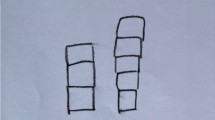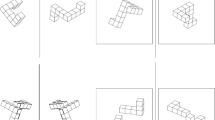Abstract
This inquiry presents two fine-grained case studies of students demonstrating different levels of cognitive functioning in relation to bilateral symmetry and reflection. The two students were asked to solve four sets of tasks and articulate their reasoning in task-based interviews. The first participant, Brittany, focused essentially on three criteria, namely (1) equidistance, (2) congruence of sides and (3) ‘exactly opposite’ as the intuitive counterpart of perpendicularity for performing reflection. On the other hand, the second participant, Sara, focused on perpendicularity and equidistance, as is the normative procedure. Brittany’s inadequate knowledge of reflection shaped her actions and served as a validation for her solutions. Intuitively, her visual strategies took over as a fallback measure to maintain congruence of sides in the absence of a formal notion of perpendicularity. In this paper, we address some of the well-known constraints that students encounter in dealing with bilateral symmetry and reflection, particularly situations involving inclined line of symmetry. Importantly, we make an attempt to show how visual and analytical strategies interact in the production of a reflected image. Our findings highlight the necessity to give more explicit attention to the notion of perpendicularity in bilateral symmetry and reflection tasks.











Similar content being viewed by others
References
Arcavi, A. (2003). The role of visual representations in the learning of mathematics. Educational Studies in Mathematics, 52, 215–241.
Australian Curriculum Assessment and Reporting Authority (2014). Foundation to year 10 curriculum (mathematics). Retrieved December 23, 2014, from http://www.australiancurriculum.edu.au/mathematics/curriculum/f-10.
Ben-Chaim, D., Lappan, G., & Houang, R. T. (1988). The effect of instruction on spatial visualization skills of middle school boys and girls. American Educational Research Journal, 25(1), 51–71.
Bulf, C. (2010). The effects of the concept of symmetry on learning geometry at French secondary school. In V. Durand-Guerrier, S. Soury-Lavergne, & F. Arzarello (Eds.), Proceedings of the 6 th conference of European research in mathematics education (pp. 726–735). Lyon: CERME.
Carroll, J. B. (1993). Human cognitive abilities—a survey of factor-analytic studies. New York: Cambridge University Press.
Clements, D. H., & Battista, M. T. (1992). Geometry and spatial reasoning. In D. A. Grouws (Ed.), Handbook of research on mathematics teaching and learning (pp. 420–464). New York: Macmillan Publishing Company.
Denys, B. (1985). The teaching of reflection in France and Japan. In L. Streefland (Ed.), Proceedings of the 9th conference of the international group for the psychology of mathematics education, vol. 1 (pp. 165–170). Noordwijkerhout: PME.
Edwards, L., & Zazkis, R. (1993). Transformation geometry: naïve ideas and formal embodiments. Journal of Computers in Mathematics and Science Teaching, 12(2), 121–145.
Ekstrom, R. B., French, J. W., & Harman, H. H. (1976). Manual for kit of factor-referenced cognitive tests. Princeton: Educational Testing Service.
Enns, J. T., & Kingstone, A. (1995). Access to global and local properties in visual search for compound stimuli. Psychological Science, 6(5), 283–291.
Gal, H., & Linchevski, L. (2010). To see or not to see: analyzing difficulties in geometry from the perspective of visual perception. Educational Studies in Mathematics, 74, 163–183.
Giannouli, V. (2013). Visual symmetry perception. Encephalos, 50, 31–42.
Grenier, D. (1985). Middle school pupils’ conceptions about reflections according to a task of construction. In L. Streefland (Ed.), Proceedings of the 9th conference of the international group for the psychology of mathematics education, vol. 1 (pp. 183–188). Noordwijkerhout: PME.
Gutiérrez, A. (1996). Visualization in 3-dimensional geometry: in search of a framework. In L. Puig & A. Gutiérrez (Eds.), Proc. 20th conference of the international group for the psychology of mathematics education (Vol. 1, pp. 3–19). Valencia: PME.
Guven, B. (2012). Using dynamic geometry software to improve eight grade students’ understanding of transformation geometry. Australian Journal of Educational Technology, 28(2), 364–382.
Hall, R. (2000). Videorecording as theory. In A. E. Kelly & R. A. Lesh (Eds.), Handbook of research design in mathematics and science education (pp. 647–664). Mahwah: Erlbaum.
Hegarty, M., & Kozhevnikov, M. (1999). Types of visual-spatial representations and mathematical problem solving. Journal of Educational Psychology, 91(4), 684–689.
Hershkowitz, R., Arcavi, A., & Bruckheimer, M. (2001). Reflections on the status and nature of visual reasoning—the case of matches. International Journal of Mathematical Education in Science and Technology, 32(2), 255–265.
Hollebrands, K. F. (2003). High school students’ understandings of geometric transformations in the context of a technological environment. Journal of Mathematical Behavior, 22, 55–72.
Hoyles, C., & Healy, L. (1997). Unfolding meanings for reflective symmetry. International Journal of Computers in Mathematical Learning, 2, 27–59.
Kosslyn, S. M. (1990). Mental imagery. In D. N. Osherson, S. M. Kosslyn, & J. M. Hollerbach (Eds.), An invitation to cognitive science (pp. 73–97). Cambridge: The MIT Press.
Kozhevnikov, M., Hegarty, M. & Mayer, R. (1999). Students’ use of imagery in solving qualitative problems in kinematics. Washington DC: US Department of Education (ERIC Document Reproduction, 433 239).
Küchemann, D. K. (1981). Reflections and rotations. In K. Hart (Ed.), Children’s understanding of mathematics 11-16 (pp. 137–157). London: John Murray.
Leikin, R., Berman, A., & Zaslavsky, O. (2000). Learning through teaching: the case of symmetry. Mathematics Education Research Journal, 12(1), 18–36.
McGee, M. G. (1979). Human spatial abilities: psychometric studies and environmental, genetic, hormonal, and neurological influences. Psychological Bulletin, 86(5), 889–918.
Piaget, J., & Inhelder, B. (1956). The child’s conception of space. London: Routledge & K. Paul.
Presmeg, N. C. (1986a). Visualisation in high school mathematics. For the Learning of Mathematics, 6(3), 42–46.
Presmeg, N. C. (1986b). Visualisation and mathematical giftedness. Educational Studies in Mathematics, 17(3), 297–311.
Yakimanskaya, I. S. (1991). The development of spatial thinking in school children. Soviet studies in mathematics education (Vol. 3). Reston: NCTM.
Yilmaz, H. B. (2009). On the development and measurement of spatial ability. International Electronic Journal of Elementary Education, 1(2), 83–96.
Zazkis, R., Dubinsky, E., & Dautermann, J. (1996). Coordinating visual and analytical strategies: a study of students’ understanding of the group D4. Journal for Research in Mathematics Education, 27(4), 435–457.
Zimmerman, W., & Cunningham, S. (1991). Editors introduction: what is mathematical visualization? In W. Zimmerman & S. Cunningham (Eds.), Visualization in teaching and learning mathematics (pp. 1–7). Washington, DC: Mathematical Association of America.
Author information
Authors and Affiliations
Corresponding author
Additional information
A preliminary and shorter version of this paper was presented in: Oesterle, S., Liljedahl, P., Nicol, C., & Allan, D. (Eds.). Proceedings of the Joint Meeting of PME 38 and PME-NA 36, 2014, Vol. 3, pp. 313–320. Vancouver, Canada: PME.
Rights and permissions
About this article
Cite this article
Ramful, A., Ho, S.Y. & Lowrie, T. Visual and analytical strategies in spatial visualisation: perspectives from bilateral symmetry and reflection. Math Ed Res J 27, 443–470 (2015). https://doi.org/10.1007/s13394-015-0144-0
Received:
Revised:
Accepted:
Published:
Issue Date:
DOI: https://doi.org/10.1007/s13394-015-0144-0




